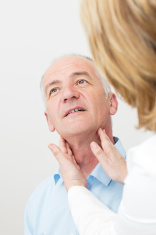The thyroid gland is a butterfly shaped organ that is in the front of your lower neck attached to the trachea, your airway. It produces thyroid hormones including thyroxine which controls your metabolism. Some thyroid diseases may be best managed with surgery. These conditions include suspicious thyroid nodules, thyroid cancer, autonomous (over active) nodules, enlargement of the gland (goitre) causing pressure in the neck, difficulty swallowing or breathing and Grave’s disease.
Thyroid nodules are incredibly common. In modern times many thyroid nodules are picked up incidentally on medical imaging investigating an unrelated issue. In this situation, often people have no symptoms and are completely untroubled by the nodule(s). The majority of thyroid nodules are benign, however some are cancerous. As a surgeon, Joanna’s role is to ascertain the likelihood of malignancy and investigate further. Ultrasound and fine needle biopsy is particularly useful and in many instances, with permission, this can be performed during a consultation. Cancer of the thyroid gland is reasonably common yet it is rarely life threatening. Surgery is the mainstay of treatment.
Some thyroid glands become dramatically enlarged due to the growth of numerous nodules, termed multinodular goitre. This condition is often hereditary or related to iodine deficiency. Pressure symptoms may occur including difficulty swallowing and breathing, or the gland may appear unsightly with a bulging neck.
Metabolic problems include Grave’s disease, an autoimmune condition where the gland is over stimulated by antibodies and produces too much thyroxine, compromising health. The gland may be swollen, known as a diffuse goitre. Endocrinologists will prescribe anti-thyroid medication and ultimately a decision to surgically remove the whole gland or use radioactive iodine ablation of the gland will be considered.
Joanna is a trained competent and experienced thyroid surgeon. She is mindful of cosmesis and will endeavour to hide the incision within a neck skin crease, and keep the incision as short as possible. As standard practice, Joanna uses a modern electrocautery device to divide blood vessels which seals the tissue with minimal blood loss. This technique has coined the term ‘sutureless thyroidectomy’. During surgery Joanna is meticulous and extremely careful to avoid complications. She will test the laryngeal nerves using a nerve integrity monitor, to check that they are still working, as it is well recognised that nerve injury is a potential complication of thyroidectomy. Following a total thyroidectomy, thyroid hormone replacement with thyroxine is necessary to maintain normal metabolism. Many patients unfortunately worry about weight gain with this treatment. This does not occur if an adequate dose of thyroxine is taken, measured easily with a simple blood test.
Useful Links

Australia and New Zealand Endocrine Surgeons
endocrinesurgeons.org.au
Disclaimer
Please remember that medical information provided by the website of Dr Joanna Morgan, in the absence of a consultation with Dr Joanna Morgan, must be considered as an educational service only. The information sent through e-mail should not be relied upon as a medical consultation. This mechanism is not designed to replace Dr Joanna Morgan’s independent judgement about the appropriateness or risks of a procedure for a given patient. The practice of Dr Joanna Morgan will do their best to provide you with information that will help you make your own health care decisions.
Convenient links to information sources are provided for further interest only. Whilst credible, Dr Joanna Morgan does not control the content of these external sites (which are periodically updated) and cannot guarantee their accuracy or relevance in one’s personal circumstances.
